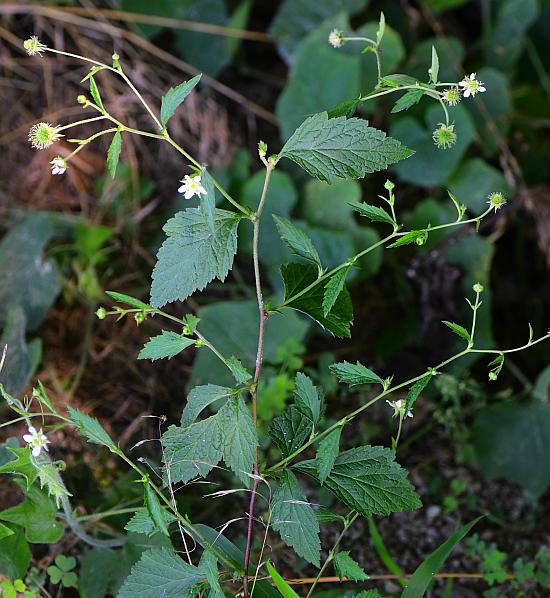Geum canadense Jacq.
White Avens

Native
CC = 2
CW = 3
MOC = 87
© SRTurner
Geum canadense Jacq.White Avens | |
 |
Native CC = 2 CW = 3 MOC = 87 |
© SRTurner |
|
Family - Rosaceae Habit - Perennial forb, from a small caudex and rhizomes. Stems - Ascending to erect, sometimes arched, to 1.0 m, the lower portion glabrous or sparsely pubescent with appressed to spreading hairs, grading upward into dense pubescence of minute velvety hairs and sometimes also sparse, longer, spreading hairs.
Leaves - Alternate, stipulate. Basal leaves simple or pinnately compound with 3-5 primary leaflets, long-petiolate; those of the stems few to several, mostly ternately compound or deeply lobed with progressively shorter petioles, the uppermost usually simple and nearly sessile. Stipules 8-24 mm long, leafy, oblong-ovate, often with few jagged lobes. Primary leaflets 2.5-15.0 cm long, broadly ovate to rhombic or lanceolate-elliptic, sometimes shallowly to deeply 3-lobed, the surfaces glabrous or more commonly sparsely to moderately short-hairy.
Inflorescences - Terminal, solitary or few-flowered, loose clusters. Flower stalks mostly relatively long (to 5 cm), densely pubescent with minute velvety hairs, sometimes also with sparse, longer, spreading hairs. the branch points usually with a stipulelike bract, the stalks often also with a pair of reduced stipulelike bracts near the midpoint. Flowers ascending or drooping. Flowers - Receptacle densely bristly-hairy. Sepals 5, 4-8 mm long, lanceolate to oblong-ovate, alternating with shorter narrower bractlets. Petals 5, free, 4-9 mm long, as long as or longer than the sepals, white, sometimes fading to cream-colored with age. Stamens numerous, borne at edge of hypanthium, spreading. Filaments to 2.5 mm long, glabrous, whitish. Anthers yellow, 0.5 mm in diameter. Carpels many. Styles persistent in fruit, elongating to 7 mm, the apical segment 1-2 mm long, sparsely to moderately pubescent with short bristly hairs toward the base.
Fruits - Cluster of fruits 10-16 mm in diameter, sessile or nearly so, not evidently raised above the calyx. Fruits with the main body 2.5-3.5 mm long, flattened but without thickened angles, sparsely to moderately bristly-hairy, the persistent stylar beak 4-7 mm long, glabrous or sparsely hairy toward the base.
Flowering - May - October. Habitat - Bottomland and mesic forests, streambanks, moist depressions of upland prairies, glade margins, pastures, fields, roadsides, railroads. Origin - Native to the U.S. Lookalikes - G. virginianum, G. laciniatum. Other info. - This is a very common woodland plant in Missouri, occurring throughout the state and the eastern half of the continental U.S. The plant is straightforward to identify on general appearance, with stipulate and often lobed leaves and flowers having numerous stamens and five white, free petals. It can be confused with G. virginianum, a more conservative and less common species which has smaller, pale yellow petals. It is also similar in appearance to G. laciniatum, which has conspicuous spreading hairs on the flower stalks rather than the velvety hairs on the flower stalks of G. canadense. Photographs taken at the Kansas City Zoo, 6-17-99 and 7-10-00, and in the Ozark Scenic Riverways, Shannon County, MO., 6-15-03 (DETenaglia); also at Weldon Spring Conservation Area, St. Charles County, MO, 7-3-2013, along the Katy Trail near Treloar, Warren County, MO, 7-4-2020, and at Tyson County Park, St. Louis County, MO, 7-8-2022 (SRTurner). |